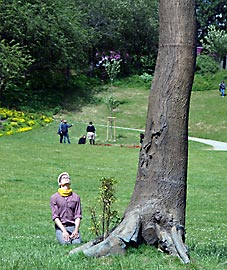 Erleuchtung und Täuschung, alles
Erleuchtung und Täuschung, alles
eine Frage des Mind (Abb. frei
nach Tsung-mi/Trinosophie-Blog*)
Unerwünschtes Gedankenkreisen lässt sich wirksam mit Meditation bannen. Dazu setzt man sich in Stille in Meditationshaltung und lenkt alle Konzentration auf den natürlich ein- und ausströmenden Atem. Wenn bald darauf – wie gewohnt – alle möglichen ungerufenen Gedanken auftauchen, lässt man die einfach an sich vorbei ziehen. Nichts als Einatmen, Ausatmen, Einatmen … Die Technik funktioniert – das hat eine im Online-Journal PloS Biology veröffentlichte Studie nachgewiesen. Schon ein dreimonatiges strenges Meditationstraining führt zu einem nachhaltigen Umbau in den für Konzentration zuständigen Hirnarealen.
Grundlage der Studie war eine dreimonatige strenge Anwendung der Vipassana-Meditation, die speziell auf die Entfaltung eines „nicht-reagierenden Gewahrseins“ ausgerichtet ist. Folge: Die Übenden werden zunehmend resistent gegen schnell wechselnde Stimuli in der Außenwelt. Obgleich äußere Reize zugleich umfassender wahrgenommen werden. Nach drei Monaten Training können die Probanden besser zuhören und werden weniger von persönlichen Vorlieben und Abneigungen getrieben.
Die Fähigkeit, sich mental und emotional nicht ablenken zu lassen, ganz gleich was um einen herum und mit einem passiert, wird in allen spirituellen Lehren als Vorbedingung für die Überwindung der Persönlichkeit und das Erlangen von Erleuchtung gewertet.
Nachfolgend ein Auszug der Online-Veröffentlichung von Rachel Jones
Citation: Jones R (2007) Learning to Pay Attention. PLoS Biol 5(6): e166 doi:10.1371/journal.pbio.0050166
Published: May 8, 2007
Copyright: © 2007 Public Library of Science. This is an open-access article distributed under the terms of the Creative Commons Attribution License, which permits unrestricted use, distribution, and reproduction in any medium, provided the original author and source are credited.
Our sensory system is constantly bombarded with inputs, but owing to the brain’s finite processing power, we are forced to pay attention to only a tiny proportion of these inputs at any given time. In a new study, Richard Davidson and colleagues report that intensive training in meditation can alter the way in which the brain allocates attentional resources to important stimuli, allowing people to improve their performance on a demanding visual task.
In the “attentional blink” task, volunteers were asked to identify two “target” stimuli—for example, two particular numbers—in a stream of rapidly presented “non-target” stimuli—for example, letters—which are irrelevant to the task. When the first target number appears on the screen, it captures the attention of the subject, and this can prevent the person from spotting the second target if it appears within around half a second of the first (the attentional blink). It is as if the brain is so busy processing the first target that it can’t also process the second, and therefore the second target goes unnoticed. However, the attentional blink does not represent a structural processing bottleneck. Most subjects are able to spot the second target on at least a small proportion of trials. Since this task gauges the ability of subjects to allocate cognitive resources efficiently when multiple stimuli compete for attention, it is perfectly suited for investigations of the effects of mental training on attention …
Linksunten: Rachel Jones: Learning to Pay Attention
Anmerkung
(*) Schon vor mehr als 1000 Jahren hat der Zen-Meister Tsung-mi (780 – 841) das Geheimnis eines klaren Verstandes und einspitziger (single-minded) Konzentration gekannt und darüber geschrieben. In der ihrem Niedergang zustrebenden Tang-Dynastie (618 – 907) gab es unter den intellektuellen Größen des Reiches eine Art Streit, ob Erleuchtung PLÖTZLICH oder eher SCHRITTWEISE erlangt werden kann. Tsung-mi, wohl aus eigener Erfahrung schöpfend, löste den Streit. Er verwies auf das MIND, das Denkprinzip, als Dreh- und Angelpunkt. Wer das Mind im Griff hat, hat letztlich alle Probleme gelöst. Auch das, von LEBEN und TOD. Erleuchtung mag irgendwann PLÖTZLICH über einen kommen. Aber ohne stetiges meditatives Training wird das nicht passieren können. Die Meditationstechnik der Zen-Mönche damals entsprach im Wesentlichen der Vipassana-Meditation.
Zuletzt aktualisiert: 31.07.2007 von Heinz Knotek






